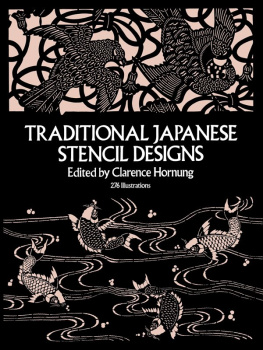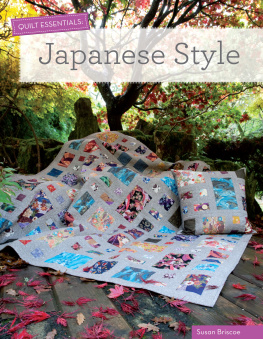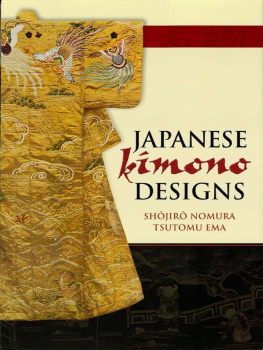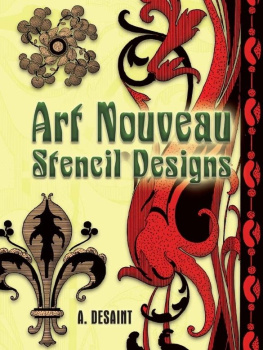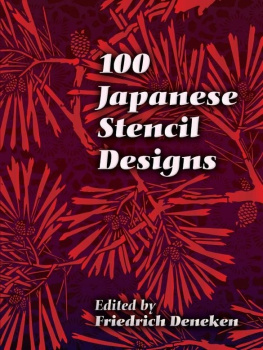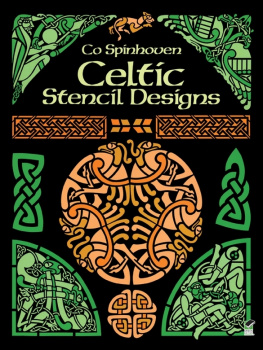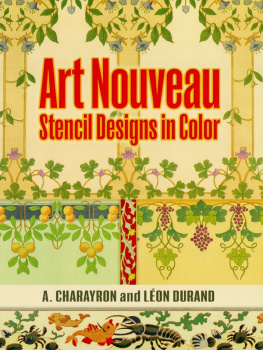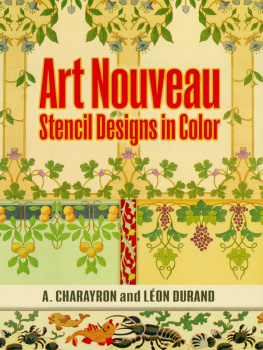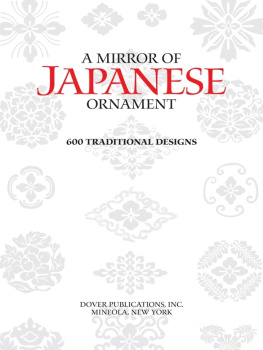Clarence Hornung - Traditional Japanese Stencil Designs
Here you can read online Clarence Hornung - Traditional Japanese Stencil Designs full text of the book (entire story) in english for free. Download pdf and epub, get meaning, cover and reviews about this ebook. year: 2013, publisher: Dover Publications, genre: Romance novel. Description of the work, (preface) as well as reviews are available. Best literature library LitArk.com created for fans of good reading and offers a wide selection of genres:
Romance novel
Science fiction
Adventure
Detective
Science
History
Home and family
Prose
Art
Politics
Computer
Non-fiction
Religion
Business
Children
Humor
Choose a favorite category and find really read worthwhile books. Enjoy immersion in the world of imagination, feel the emotions of the characters or learn something new for yourself, make an fascinating discovery.
- Book:Traditional Japanese Stencil Designs
- Author:
- Publisher:Dover Publications
- Genre:
- Year:2013
- Rating:4 / 5
- Favourites:Add to favourites
- Your mark:
- 80
- 1
- 2
- 3
- 4
- 5
Traditional Japanese Stencil Designs: summary, description and annotation
We offer to read an annotation, description, summary or preface (depends on what the author of the book "Traditional Japanese Stencil Designs" wrote himself). If you haven't found the necessary information about the book — write in the comments, we will try to find it.
Traditional Japanese Stencil Designs — read online for free the complete book (whole text) full work
Below is the text of the book, divided by pages. System saving the place of the last page read, allows you to conveniently read the book "Traditional Japanese Stencil Designs" online for free, without having to search again every time where you left off. Put a bookmark, and you can go to the page where you finished reading at any time.
Font size:
Interval:
Bookmark:
TRADITIONAL JAPANESE STENCIL DESIGNS
Edited by
Clarence Hornung

Dover Publications, Inc., New York
To SARA
1900 : 1981
In Sweet Remembrance

Copyright 1985 by Dover Publications, Inc.
All rights reserved under Pan American and International Copyright Conventions.
Traditional Japanese Stencil Designs, a new work first published by Dover Publications, Inc., in 1985, consists of an Introduction by Clarence Hornung and a selection by him of plates from published Japanese sources.
DOVER Pictorial Archive SERIES
This book belongs to the Dover Pictorial Archive Series. You may use the designs and illustrations for graphics and crafts applications, free and without special permission, provided that you include no more than four in the same publication or project. (For permission for additional use, please write to Dover Publications, Inc., 31 East 2nd Street, Mineola, N.Y. 11501.)
However, republication or reproduction of any illustration by any other graphic service whether it be in a book or in any other design resource is strictly prohibited.
Manufactured in the United States of America
Dover Publications, Inc., 31 East 2nd Street, Mineola, N.Y. 11501
Library of Congress Cataloging in Publication Data
Main entry under title:
Traditional Japanese stencil designs.
(Dover pictorial archive series)
1. Stencil workJapanThemes, motives. I. Hornung, Clarence Pearson. II. Series.
NK8665.J3T71985745.7384-21254
ISBN 0-486-24791-0
INTRODUCTION
The vast panoramic scope of Japanese design, infinite as the heavens and boundless as the seas, is deeply rooted in the realm of nature. A reverence for all living things, an integral part of Buddhist and Shinto religions, engenders an awesome sense of beauty that embraces natural forces and animate creatures seldom glorified in the cultures of the West. Trees, mountains, rivers and celestial bodies are embodied as deified spirits, sanctified and worshipped with awe and affection. Sun, sky and sea... birds, beasts and butterflies... countless flora and fauna... these are the omnipresent elements of nature that provide and enrich the Japanese design vocabulary. For ages and ages these have served the artist symbolically and as embellishment and ornamentation, not only on kimonos and household goods but also on objects of sacred use in shrines. Woven textiles with delicate floral patterns and metalwork decorated with arabesques, blossoms and beasts appear as early as the Heian period (7941185). Lacquers and items for personal use were decorated with naturalistic themes; the more personal the purpose, the more detailed and delicate the ornamentation.
In the gradual process of continuing development the Japanese craftsman learned to adapt and simplify design forms until they attained a degree of purity through progressive evolution. Each motif reached a stage of graphic perfection akin to shorthand symbols, which made their application to decorative usage ideal. For example, one can make a case study of the chrysanthemum ( kiku ), Nippon's imperial flower, and observe literally hundreds of variants so greatly conventionalized in construction and arrangement of petals as to produce endless diversity of decorative interpretations. This extraordinary talent of the Japanese to reduce representational forms to ideographic motifs makes patterns inviting, intriguing and always optically exciting.
To attempt an inventory of these sources of inspiration would be as hopeless as trying to count the heavenly bodies on a clear, starry night. Yet some simple classification would be helpful in categorizing the boundless domain of the world of nature. Above all, the heavens have held an endless fascination for the Japanese. Cloud patterns ( kumo ) assume many different forms, often cumulus, wavy or nebulous, changing into mist ( kasumi ). Lightning ( inazuma ), with its martial connotations and the thunderbolt, lends itself to stylization, suggesting fecundity and the basic forces of life. Most familiar in Japanese prints and paintings, and carried over into graphic representations, is the moon ( tsuki ) in its various phases, perennially suggestive of poetic imagery. It is often combined with other motifs that can be traced back to Chinese origins as a manifestation of yin, the passive or female force in the universe. Just as the early Japanese of the Nara and Heian periods borrowed freely from Chinese astrology, so the stars ( hoshi ) have figured prominently in traditional pattern decoration of the Japanese. The star as a symmetrical entity or used in groups of three, five or seven was popularized by the shogun and warrior classes for centuries past. But the capstone of all heavenly bodies remains the sun ( hi ), which appears as the big red disc or rising sun that had its origins over a thousand years ago. It was in 1854, coinciding with Admiral Perry's epochmaking treaty, that it was adopted as a national emblem and shortly thereafter as the imperial emblem on the nation's flag. The firm basis for the sun's universal acceptance lies in the legends that trace the origins of the imperial line to the Sun Goddess. The completeness of the circular disc, without beginning or end in its linear outline, accounts for its versatile use as a design motif and its persistent popularity in all forms of decoration.
When the Japanese designer turns his attention to the botanical world of trees, plants, buds, blossoms and flowers, he taps a wealth of untold riches, so vast in the scope of its bounties that few Western cultures approach its infinite resources. The bamboo ( take ) has no rival in the great adaptability of its many parts: stem, leaf form, canes and overall outline. Its grace and versatility have made it extraordinarily popular since ancient times, when it was imported from China. Developed into 150 varieties, the bamboo's usefulness extends into many disparate fields including structural materials, fencing, basketry, brooms, rakes, hats, ladders, lattices, arrows, flutes, fishing rods and even foodstuffs. It is not surprising in view of such universality that to the decorator it offers unlimited design choices in combinations of leafy fronds, cane shoots and bud formations. For sheer grace and elegance the overlapping stems and cane shoots, enriched with their delicate leaf forms, invite caprice and playfulness, always a visual delight in endless combinations. In contrast to the bamboo, the stately coniferous cryptomeria ( sugi ) offers its majestic form to indicate and symbolize Shinto torii and shrine gables and gateways, while its slender needles have inspired many intricate design arrangements.
A favorite theme with artists, poets and writers is the cherry blossom ( sakura ), far outstripping other blooms in its manifold applications. From about the tenth century onward it was so popular that it was referred to merely as the flower, or hana. Its nearest rival is the chrysanthemum ( kiku ), the Japanese imperial flower. Its formalized sixteen-petal arrangement radiating out from its center suggested the sunburst, and so it came to be referred to as sun splendor ( nikka ) and the sun spirit ( nissei ), whose origins go back several thousand years in time. This regal flower symbolized the finest and highest aspirations in the spiritual and temporal world. There are reputed to be as many as five thousand varieties of the chrysanthemum in a profusion of colors, sizes, shapes and forms. It follows quite naturally that in the arts and crafts such widespread omnipresence should be reflected in far-ranging decorative applications.
Next pageFont size:
Interval:
Bookmark:
Similar books «Traditional Japanese Stencil Designs»
Look at similar books to Traditional Japanese Stencil Designs. We have selected literature similar in name and meaning in the hope of providing readers with more options to find new, interesting, not yet read works.
Discussion, reviews of the book Traditional Japanese Stencil Designs and just readers' own opinions. Leave your comments, write what you think about the work, its meaning or the main characters. Specify what exactly you liked and what you didn't like, and why you think so.

